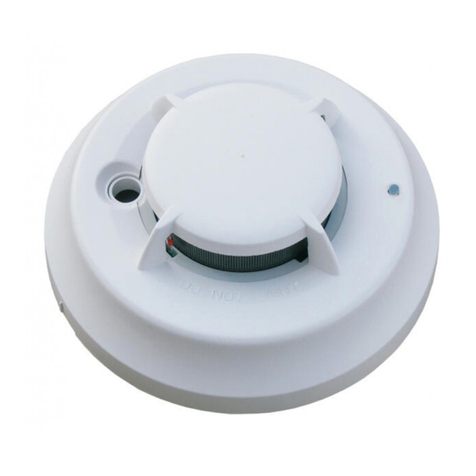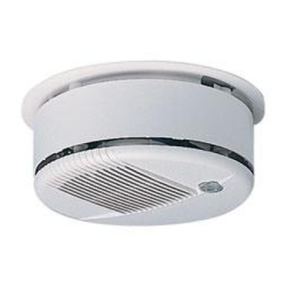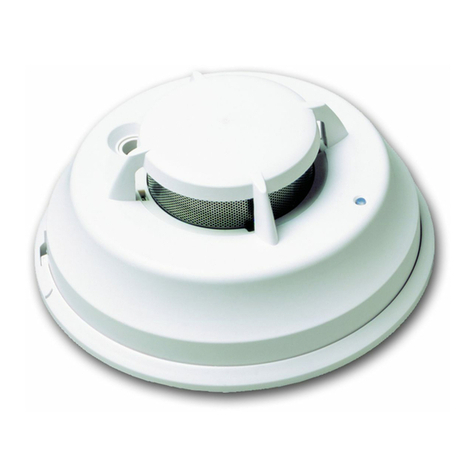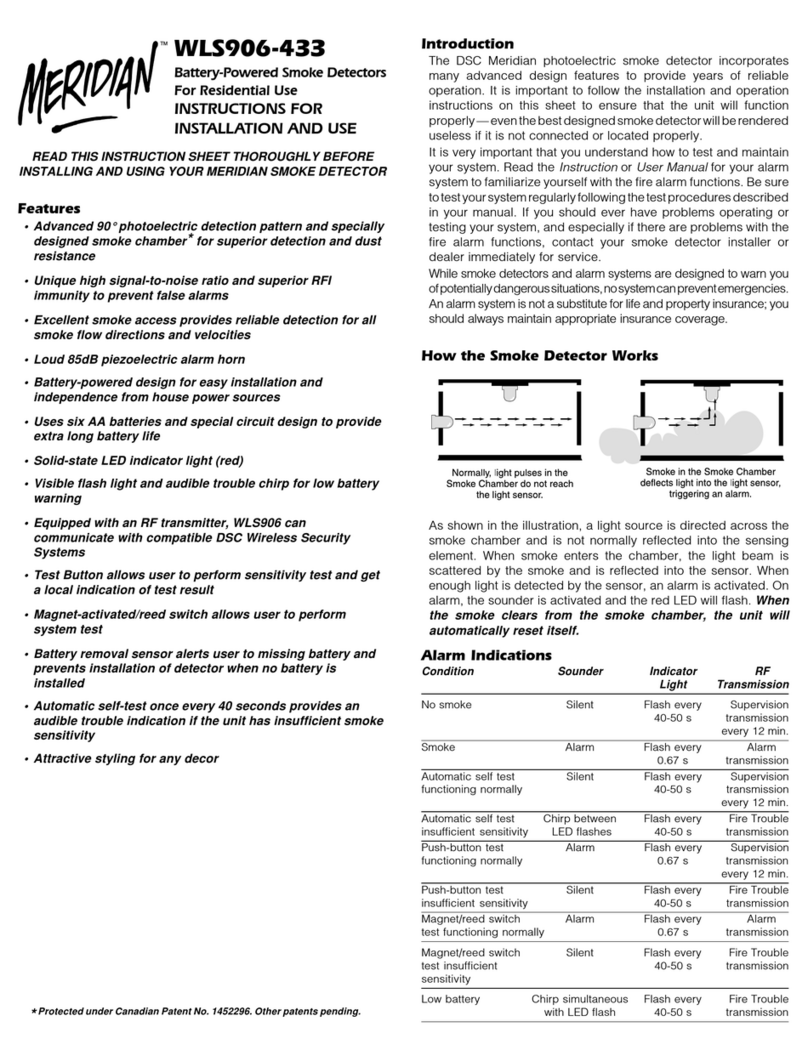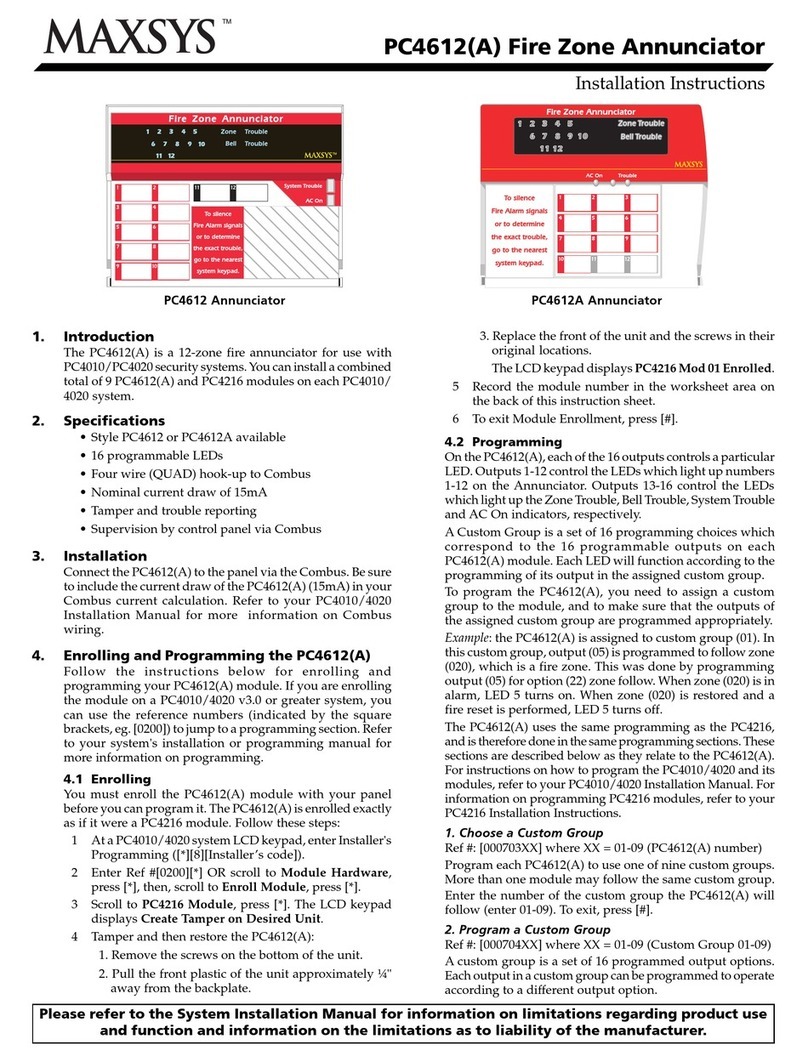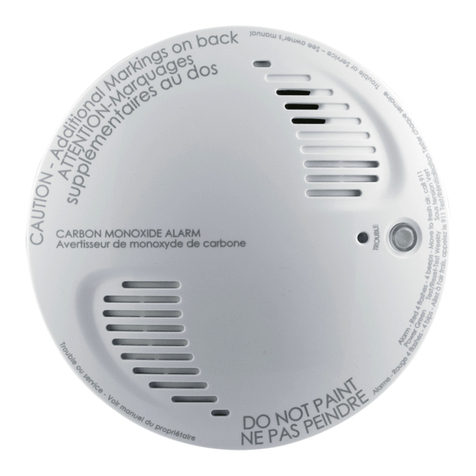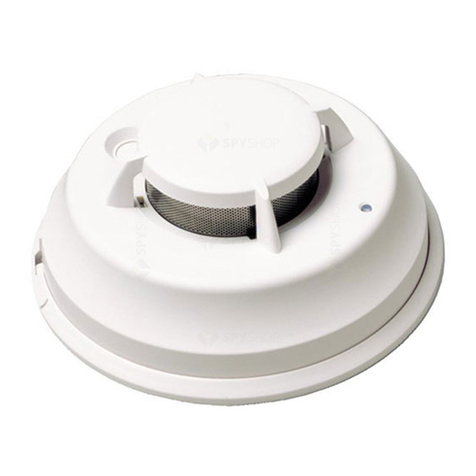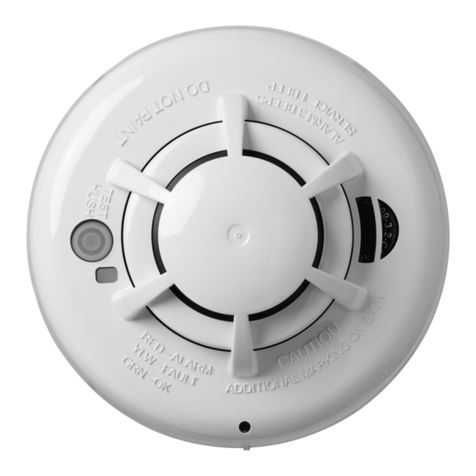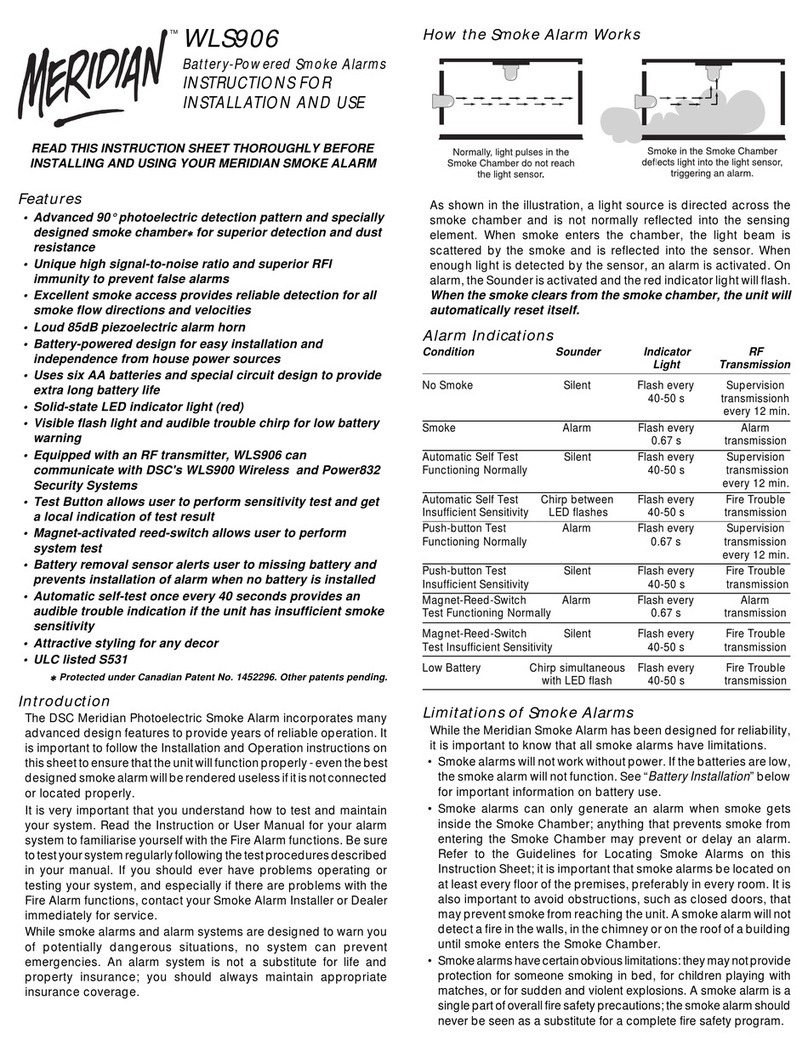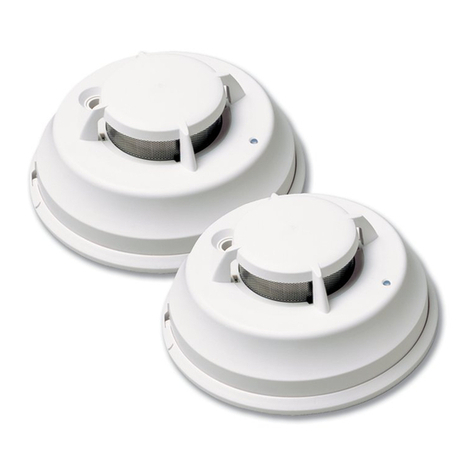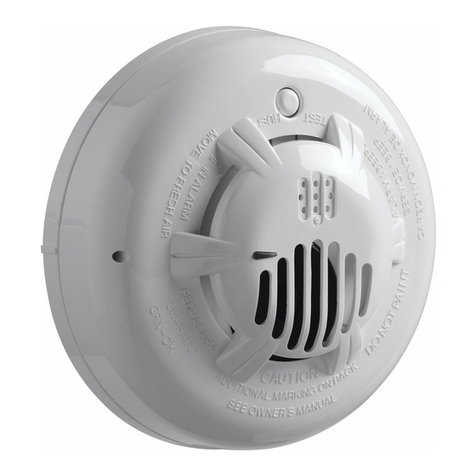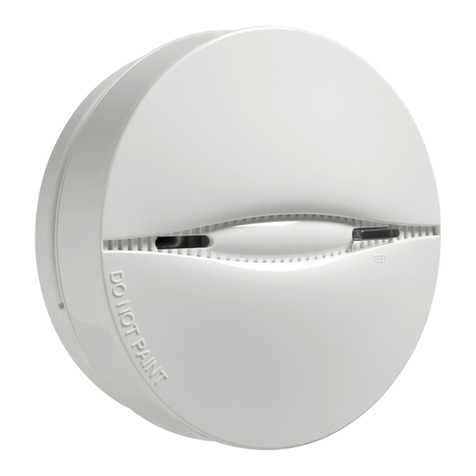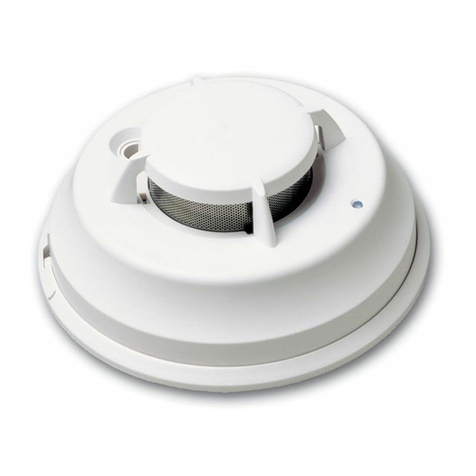
™
Field Test.................................. Magnet-activated switch and/or
...................................... Gemini 501 Smoke Alarm Analyser**
Smoke Detector Mounting Plate
When wiring is completed, inspect the wiring and correct any errors
before applying power to the unit. When the wiring has been
thoroughly reviewed, neatly insert the wires into the electrical box
and secure the unit to the mounting plate.
For Information and Technical Assistance:
Digital Security Controls Ltd.
1645 Flint Road
Downsview, Ontario, Canada M3J 2J6
Phone: (416) 665 8460
Fax: (416) 665 7498
Mounting
Holes
Locking Tab
THIS SIDE OUT
Form C Aux. Relay wires
dress through this opening
Power and Form A Relay wires
dress through this opening
functions of the alarm control system and any equipment, such as
smoke detectors, connected to it. The user should be provided with
all Instruction Sheets and Manuals for their system and any
components connected to it. Complete and thorough instruction for
the user is essential to ensure they will obtain the greatest benefit
from their system. Providing the user with complete operational
information will also benefit the Installer through a reduction in
service calls for nuisance alarms.
Limited Warranty
Digital Security Controls Ltd. warrants that for a period of twelve
months from the date of purchase, the product shall be free of
defects in material and workmanship under normal use and that in
fulfilment of any breach of such warranty, Digital Security Controls
Ltd. shall, at its option, repair or replace the defective equipment
upon return of the equipment to its repair depot. This warranty
appliesonly todefectsinpartsand workmanshipandnot todamage
incurred in shipping or handling, or damage due to causes beyond
control of Digital Security Controls Ltd. such as lightning, excessive
voltage, mechanical shock, water damage, or damage arising out of
abuse, alteration or improper application of the equipment.
The foregoing warranty shall apply only to the original buyer, and is
and shall be in lieu of any and all other warranties, whether express
orimpliedandofallotherobligationsorliabilitiesonthepartofDigital
Security Controls Ltd. This warranty contains the entire warranty.
Digital Security Controls Ltd. neither assumes, nor authorizes any
otherpersonpurportingtoactonitsbehalftomodifyortochangethis
warranty,nortoassumeforitanyotherwarrantyorliabilityconcerning
this product.
Innoevent shallDigitalSecurityControls Ltd.beliablefor anydirect,
indirect or consequential damages, loss of anticipated profits, loss
of time or any other losses incurred by the buyer in connection with
the purchase, installation or operation or failure of this product.
WARNING
DigitalSecurityControlsLtd.recommendsthattheentiresystem
becompletelytestedonaregularbasis.However,despitefrequent
testing, and due to but not limited to, criminal tampering or
electrical disruption, it is possible for this product to fail to
perform as expected.
Smoke detectors that are a part of this system may not properly
alert occupants of a fire for a number of reasons, some of which
follow.Thesmokedetectorsmayhavebeenimproperlyinstalled
or positioned. Smoke may not be able to reach the smoke
detectors, such as when the fire is in a chimney, walls or roofs,
or on the other side of closed doors. Smoke detectors may not
detect smoke from fires on another level of the residence or
building.
Every fire is different in the amount of smoke produced and the
rate of burning. Smoke detectors cannot sense all types of fires
equally well. Smoke detectors may not provide timely warning
of fires caused by carelessness or safety hazards such as
smoking in bed, violent explosions, escaping gas, improper
storage of flammable materials, overloaded electrical circuits,
children playing with matches or arson.
Even if the smoke detector operates as intended, there may be
circumstances when there is insufficient warning to allow all
occupants to escape in time to avoid injury or death.
1 Every family member should participate in developing the escape
plan.
2 Study the possible escape routes from each location within the
house.Sincemany firesoccuratnight,specialattentionshould be
given to the escape routes from sleeping quarters.
3 It is essential that escape from a bedroom be possible without
opening the interior door. Consider the following when making
your escape plans:
• Make sure that doors and windows that open to the outside are
easilyopened. Ensurethat theyarenotpaintedshut, andthat their
locking mechanisms operate smoothly.
• If opening the exit or using the exit is too difficult for children, the
elderly or handicapped, plans for rescue should be developed.
Thisincludesmakingsurethatthosewhoaretoperformtherescue
can promptly hear the fire warning signal.
• Iftheexitisabovethegroundlevel,anapprovedfireladderorrope
should be provided, as well as training in its use.
• Exits on the ground level should be kept clear. Be sure to remove
snow from exterior patio doors in winter; outdoor furniture or
equipment should not block exits.
• The family should have a predetermined assembly point where
everyone can be accounted for; for example, across the street or
at a neighbour’s house.
• Once everyone is out of the house, call the Fire Department.
• A good plan emphasizes quick escape. Do not investigate first or
attempt to fight the fire, and do not attempt to rescue belongings
or valuables as this takes up time. Once outside, do not re-enter
the house; wait for the Fire Department.
• Write the plan down and rehearse frequently so that should an
emergency arise, everyone will know what to do. Revise the plan
as conditions change; for example, when there are more or fewer
family members in the home, or if there are changes to the house.
• Make sure your fire warning system is operational by conducting
weekly tests. If you are unsure about system operation, contact
your Smoke Detector Installer or Dealer.
• Itisrecommended thatyoucontact yourlocal fire departmentand
requestfurtherinformationonhomefiresafetyandescapeplanning.
If available, have your local fire prevention officer conduct an in-
house fire safety inspection.
Installation Instructions
Specifications
Nominal Operating Voltage ......................12 - 24VDC or VFWR
Maximum Operating Voltage Range .................10 - 30VDC, or
.............................................................................. 10 - 26.4VFWR
Standby Current
@12V @24V
MN220 15µA 50µA
MN220T 25µA 60µA
MN220R 15µA 65µA
MN220RT 30µA 75µA
MN220 Series Compatiblity Identifier:............................. PS220
Compatible Control Units:
DSC PC5010 with compatibility identifier: ....................... PC5-1
Maximum no. of detectors per zone: ..................................... 30
Min. detector voltage/current
to operate relay (MN220R, MN220RT): ................. 7.5VDC/35mA
Auxiliary Relay Rating (Resistive)
Form C Relay...............................................2A at 30VDC / VAC
Temp Sensor.................................................... 57oC (135°F) fixed
Smoke Sensitivity....................2.0%/ft obscuration ±0.6%/ft (UL)
Operating Environment .......................0°C - 50°C (32°F - 100°F)
..................................................5% - 93% RH, non-condensing ** Gemini Scientific, 1122B Aster Ave., Sunnyvale, CA 94086 Tel: 408-554-0310
Dimensions
Wiring (bottom view)
2-Wire Detector System Wiring
Models: MN220
MN220T Models: MN220R
MN220RT
Installation Testing
When all connections are completed, apply power to the system as
describedinthecontrolpanel’sInstallationManual. Ifallconnections
are correct, there should be no alarm from any of the smoke
detectors. Ifanalarmoccurs,ensurethatthereisnotanactualalarm
condition. If there is no actual alarm, remove power from the system
and check all smoke detectors for correct wiring.
If no alarm occurs, test each smoke detector by holding the test
magnet against the case near the Alarm Indicator. Refer to the
illustration in the “Testing Your Smoke Detector” section of these
instructions.When the magnetis inplace, analarm willbeactivated:
the Alarm Indicator Light will come ON, the Auxiliary Relay will be
activated,andthe alarmcontrol panelwill indicatea firealarm. When
the magnet is removed, the detector will remain latched in the alarm
condition. To reset the detector, remove the power supplied by the
alarm control panel.
Installer’s Maintenance Instructions
Normally,theMeridianSmokeDetectorwillnotrequiremaintenance.
Iftheunitismountedinahigh dustenvironment,theinletareas ofthe
case may be vacuumed with a soft brush attachment.
Be sure to inform the user and their monitoring station when
maintenance of any sort is performed on the smoke detector or any
part of the alarm control system. Always test smoke detectors after
maintenance. If a smoke detector continues to generate nuisance
alarms even after vacuuming, return the unit to DSC for service.
Contact DSC at the address and number below to obtain a return
authorisation number before returning the unit.
Installer’s Responsibility to the User
Itisthe Installer’sresponsibility tothoroughly instruct theend userof
the system on the operation, testing and maintenance of their
system. The Installer should fully explain and demonstrate all
Mounting the Unit
The Meridian Smoke
Detector mounts to a
standard 4" octagonal
electrical box.
12 to 24V
DC
or Full Wave Rectified
power must be supplied
fromaUL/ULC-listedalarm
controlunit. Wiringshould
be in accordance with the
appropriate national
electrical code and
applicable local codes.
Remove the mounting plate
from the case by pushing the locking tab and turning the mounting
plate counter-clockwise. Attach the mounting plate to the electrical
box (see diagram above for orientation).
THISEQUIPMENTSHOULDBEINSTALLEDINACCORDANCEWITH
THE NATIONAL FIRE PROTECTION ASSOCIATION’S STANDARD
72.(NationalFireProtectionAssociation,BatterymarchPark,Quincy,
MA 02269)
Wiring
Refer to the wiring diagrams on this installation sheet and those
provided in the Installation Manual of the alarm control panel being
used with the unit.
Before connecting the unit, prepare the wires from the electrical box
for connection; the wires should not be frayed or bent.
CAUTION: If the power connections are reversed, the unit will
notoperate. Theunitisprotectedagainstdamagefromincorrect
wiring.
CAUTION: FORSYSTEMSUPERVISION,DONOTUSELOOPEDWIRE
UNDER TERMINALS. BREAK WIRE RUN TO PROVIDE
SUPERVISION OF CONNECTIONS.
5.13"
131 mm
2.0"
51 mm
Test Button &
Alarm Indicator
29002397 R0
August1997
